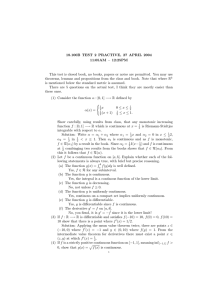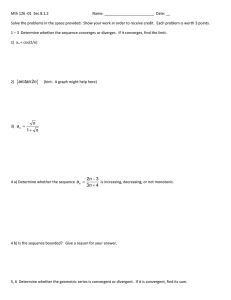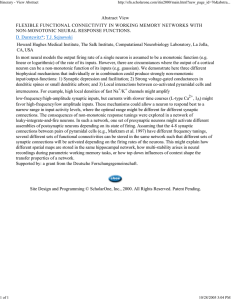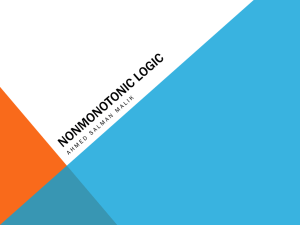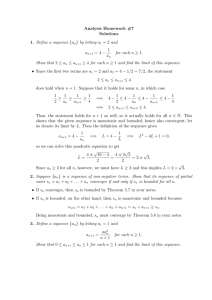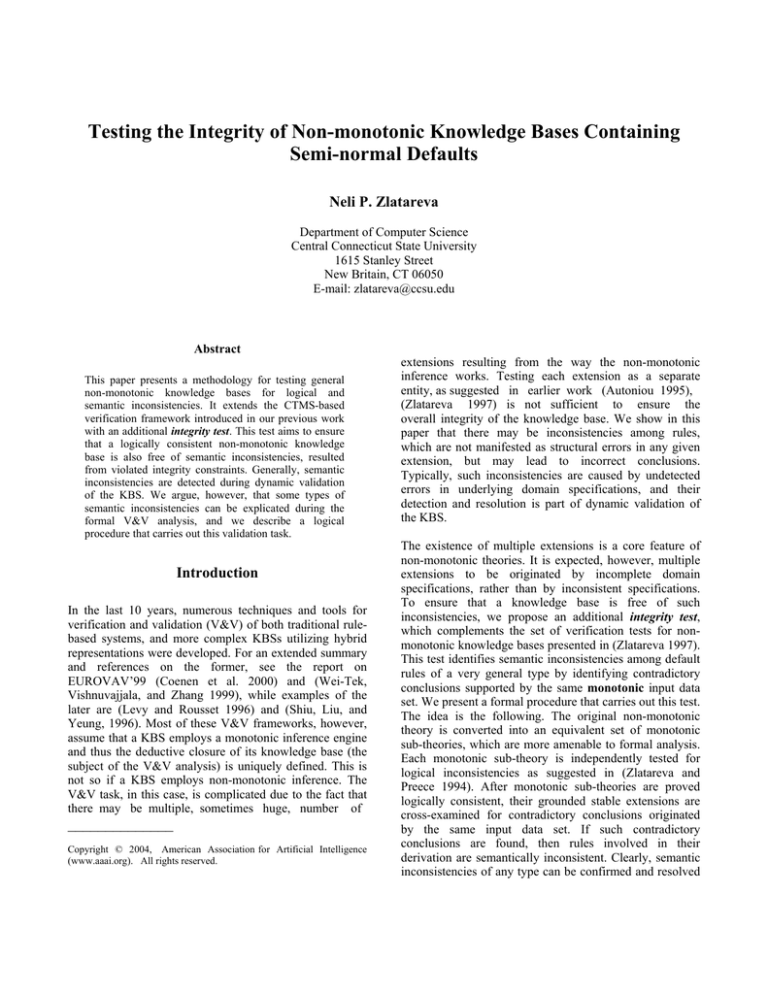
Testing the Integrity of Non-monotonic Knowledge Bases Containing
Semi-normal Defaults
Neli P. Zlatareva
Department of Computer Science
Central Connecticut State University
1615 Stanley Street
New Britain, CT 06050
E-mail: zlatareva@ccsu.edu
Abstract
This paper presents a methodology for testing general
non-monotonic knowledge bases for logical and
semantic inconsistencies. It extends the CTMS-based
verification framework introduced in our previous work
with an additional integrity test. This test aims to ensure
that a logically consistent non-monotonic knowledge
base is also free of semantic inconsistencies, resulted
from violated integrity constraints. Generally, semantic
inconsistencies are detected during dynamic validation
of the KBS. We argue, however, that some types of
semantic inconsistencies can be explicated during the
formal V&V analysis, and we describe a logical
procedure that carries out this validation task.
Introduction
In the last 10 years, numerous techniques and tools for
verification and validation (V&V) of both traditional rulebased systems, and more complex KBSs utilizing hybrid
representations were developed. For an extended summary
and references on the former, see the report on
EUROVAV’99 (Coenen et al. 2000) and (Wei-Tek,
Vishnuvajjala, and Zhang 1999), while examples of the
later are (Levy and Rousset 1996) and (Shiu, Liu, and
Yeung, 1996). Most of these V&V frameworks, however,
assume that a KBS employs a monotonic inference engine
and thus the deductive closure of its knowledge base (the
subject of the V&V analysis) is uniquely defined. This is
not so if a KBS employs non-monotonic inference. The
V&V task, in this case, is complicated due to the fact that
there may be multiple, sometimes huge, number of
______________
Copyright © 2004, American Association for Artificial Intelligence
(www.aaai.org). All rights reserved.
extensions resulting from the way the non-monotonic
inference works. Testing each extension as a separate
entity, as suggested in earlier work (Autoniou 1995),
(Zlatareva 1997) is not sufficient to ensure the
overall integrity of the knowledge base. We show in this
paper that there may be inconsistencies among rules,
which are not manifested as structural errors in any given
extension, but may lead to incorrect conclusions.
Typically, such inconsistencies are caused by undetected
errors in underlying domain specifications, and their
detection and resolution is part of dynamic validation of
the KBS.
The existence of multiple extensions is a core feature of
non-monotonic theories. It is expected, however, multiple
extensions to be originated by incomplete domain
specifications, rather than by inconsistent specifications.
To ensure that a knowledge base is free of such
inconsistencies, we propose an additional integrity test,
which complements the set of verification tests for nonmonotonic knowledge bases presented in (Zlatareva 1997).
This test identifies semantic inconsistencies among default
rules of a very general type by identifying contradictory
conclusions supported by the same monotonic input data
set. We present a formal procedure that carries out this test.
The idea is the following. The original non-monotonic
theory is converted into an equivalent set of monotonic
sub-theories, which are more amenable to formal analysis.
Each monotonic sub-theory is independently tested for
logical inconsistencies as suggested in (Zlatareva and
Preece 1994). After monotonic sub-theories are proved
logically consistent, their grounded stable extensions are
cross-examined for contradictory conclusions originated
by the same input data set. If such contradictory
conclusions are found, then rules involved in their
derivation are semantically inconsistent. Clearly, semantic
inconsistencies of any type can be confirmed and resolved
only by a domain expert, but we argue that explicating
them as part of the formal V&V process helps improve the
efficiency of dynamic validation, which is still considered
the “bottleneck” in KBS quality assurance.
The paper is organized as follows. First, we discuss some
issues in verification and validation of non-monotonic
KBSs that motivated the research presented in this paper.
Next, we outline the proposed integrity test, and define the
type of knowledge bases that we target. We then introduce
a conversion procedure that allows a non-monotonic
theory to be converted to a set of semantically equivalent
monotonic theories, and show how the proposed integrity
test is carried out. An extended example is used throughout
the paper to illustrate the presentation.
set or its monotonic supersets. If such contradictory
formulas are found, then there are semantic inconsistencies
among rules involved in their derivation. To identify the
“wrong” rule (or rules), we can use test cases already
contained in the grounded versions of the extensions
involved. Grounded stable extensions are operational
theories, which are generated by computing the transitive
closure of the formulas comprising stable extensions
(deductive closures) of the original theory. In a grounded
stable extension, each conclusion is defined in terms of the
underlying input data set, which, in turn, defines a test case
for that conclusion. To validate extensions, we can
compare test cases associated with suspicious conclusions
to real-world test cases. This simple idea is easy to
implement for monotonic knowledge bases; however, its
implementation for non-monotonic knowledge bases
turned out to be not trivial. One solution is discussed next.
Issues in V&V of non-monotonic KBS
Verification and validation of non-monotonic theories was
sparingly addressed in the V&V literature, although related
topics, such as belief revision and knowledge refinement,
are widely studies and discussed by AI theoreticians and
logicians (see Proceedings of the 8th International
Workshop on Non-Monotonic Reasoning for references).
This is partly due to the fact that non-monotonic KBSs are
still at early development stages, and partly due to the wide
spread belief that these systems are incomplete and
inconsistent by nature, which is why they cannot be
satisfactory validated. On the other hand, the behavior of
non-monotonic systems is far more complex than that of
monotonic systems. This steams from the fact that nonmonotonic inference is flexible enough to continue in the
presence of missing data, which considerably reduces the
size of the knowledge base, but introduces the well known
multiple extension problem. The complexity of the V&V
process jumps according to the number of extensions. Each
extension now must be tested to ensure its structural
correctness and validity, and also the theory as a whole
must be tested to ensure that there are no inconsistencies
among extensions resulted from violated integrity
(semantic) constraints.
Testing extensions for structural anomalies and errors
(such as logical inconsistencies, circularities, redundancies,
etc.) is not hard because extensions are, in fact, monotonic
theories. Any verification technique for monotonic KBSs
can be applied to them as well. The validation task, on the
other hand, is to ensure that every extension contains all
and only correct conclusions. To fully solve this task we
need test cases with known solutions. As it is well known,
this is a high complexity task even for monotonic KBSs,
where we deal with a single extension. Assume, however,
that we limit the validation task to only identifying
extensions, which possibly contain invalid conclusions.
This can be done by cross-examining extensions in search
for contradictory formulas implied by the same input data
Definition of the validation task: a case study
Let a knowledge base consists of rules of the following
type:
Ri: (premise_1, …, premise_n) (assumption_1,…,
assumption_m) Æ conclusion_i.
Here (premise_1,…,premise_n) is the set of monotonic
supporters for conclusion_i, called for short In-list,
(terminology adapted from (Doyle, 1979)), and
(assumption_1,…,assumption_m) is the set of nonmonotonic supporters for conclusion_i, called for short
Out-list. Conclusion_i holds if and only if all of its
monotonic supporters hold, and none of its non-monotonic
supporters holds. Conclusions may serve as both
monotonic and non-monotonic supporters for other
conclusions.
Rules, such as Ri, are very general semi-normal defaults.
Normal defaults and monotonic rules, respectively, can be
expressed in this form as follows:
Rj: (premise_1,..,premise_n) (¬conclusion_i) Æ
Æ conclusion_i
Rk: (premise_1,...,premise_n) ( ) Æ conclusion_i
Consider the following example theory, which is used
throughout the paper to illustrate the proposed technique:
R1: (A1, A2) ( ) Æ C1
R2: (C1, A3) ( ) Æ C2
R3: (A4, A5) (A8, A9) Æ C2
R4: (C2, A6) (C1) Æ C3
R5: (C3, A7) ( ) Æ C4
R6: (C4, C2) ( ) Æ C5
R7: (C5, A8) ( ) Æ C6
R8: (C6, A9) ( ) Æ C7
R9: (A7) (C3) Æ C4
that stable extensions of monotonic sub-theories
are semantically equivalent to possible extensions
of the original theory.
For the purposes of the V&V analysis, we treat all input
data (A1 through A9) as assumptions. Conclusions are
denoted as C1, C2, etc.
2.
Assumptions may or may not have values. For example,
A8 and A9 may be true, false, or unknown. If they are
unknown (or false), R3 will fire if its monotonic supporters
hold. In this sense, A8 and A9 are different from A4 and
A5, which must be true for R3 to fire.
Test each monotonic extension for logical
inconsistencies and other structural anomalies and
errors as described in (Zlatareva and Preece
1994).
3.
Once the internal consistency of each extension is
ensured,
cross-examine
grounded
stable
extensions of monotonic sub-theories for
contradictory conclusions extending the same
input data set, to test for violated integrity
constraints.
In general, there may be a huge number of specific
assignments of values to assumptions, where each
assignment set defines a real situation in the problem
domain (test case). In verification analysis, we are not
interested in any particular assignment; rather, we study
interactions between rules assuming that all input data is
simultaneously passed to the system. This explicates all
potential anomalies (real and false) without running test
cases.
When we deal with a non-monotonic theory, a difficulty
arises from the existence of unknown data (assumptions).
These data cannot be given values at the start of the
verification process, because this would change the
meaning of the rules containing them. This makes it
impossible to compute grounded versions of nonmonotonic theory extensions, which are the ones examined
for structural anomalies. To get around this difficulty, we
suggest original non-monotonic theory to be converted into
a set of monotonic sub-theories, stable extensions of which
are semantically equivalent to extensions of the original
theory. What we gain from this conversion is that now we
deal with monotonic extensions, grounded versions of
which are easy to compute. Moreover, the verification
framework introduced in (Zlatareva and Preece 1994) can
be applied directly to test these theories for a variety of
anomalies and errors, not just logical inconsistencies.
Assuming that each one of these monotonic theories was
tested and proved to be structurally correct, the next step
towards validating the original non-monotonic theory is to
ensure that the union of derivative monotonic theories do
not contain contradictory conclusions underlined by the
same input data set. If this is the case, then the original
non-monotonic theory contains inconsistencies among
rules that result from violated integrity constraints, which
may lead to functional errors (wrong conclusions reported
by the KBS).
In summary, the following three steps outline the V&V
process that we have described.
1.
Convert the original non-monotonic theory into
an equivalent set of monotonic sub-theories, such
The rest of this paper deals with steps 1 and 3 of the
outlined V&V process. Next, we show how the conversion
of a non-monotonic theory into an equivalent set of
monotonic sub-theories is carried out.
Conversion of a non-monotonic knowledge
base into an equivalent set of monotonic
theories
The purpose of converting a non-monotonic theory to a set
of monotonic theories is that the later are more amenable
to formal V&V analysis than the original theory. The
following definition states the conditions under which a
non-monotonic theory and a set of monotonic theories are
considered semantically equivalent.
Definition. A non-monotonic theory Thnm is semantically
equivalent to a set of monotonic theories Thm1, Thm2, …,
Thmi iff:
a)
The number of extensions of Thnm is exactly equal
the number of monotonic theories in the set.
b) For every monotonic theory, there exists a nonmonotonic theory extension such that the stable
extension of the monotonic theory contains all of
the formulas from the non-monotonic theory
extension, i.e. EXTThnm ⊆ EXTThmi.
The suggested transformation is carried out in two steps:
1.
Each non-monotonic rule is converted into a set
of monotonic ones.
2.
Consistent subsets of assumptions that originate
possible extensions of the non-monotonic theory
are identified. The monotonic theory, resulted
from the first step, is divided into a number of
theories each containing only those rules of the
initial theory that are activated by identified
assumption subsets.
Converting non-monotonic rules into monotonic ones
turned out to be surprisingly subtle. The semantics of
default rules must be carefully accounted for, which is why
the following three cases are considered separately.
Case 1. The original rule has an empty Out-list and its
conclusion does not belong to the Out-list of any other
conclusion. An example of such rule is R2 (see example
theory above). These rules are the easiest to convert,
because they are, in fact, monotonic rules. R2 can be
recorded as:
R2*: C1 ∧ A3 Æ C2
Case 2. The original rule has an empty Out-list, but its
conclusion serves as a non-monotonic supporter for
another conclusion. R1 is an example of such rule. Its
conclusion, C1, is a non-monotonic supporter for C3 (the
conclusion of R4). Consistent with the semantics of default
rules, the stronger (monotonic) version of R4 will include
¬C1 as a premise. Therefore, there must be an additional
rule (or rules) stating when ¬C1 holds. This results in the
following set of monotonic rules that R1 translates to:
R1*: A1 ∧ A2 Æ C1
R1A*: ¬A1 Æ ¬C1
R1B*: ¬A2 Æ ¬C1
Case 3: The original rule has a non-empty Out-list.
Example of such rule is R3. It will not fire if any of its
non-monotonic supporters holds. This translates into
following implications:
R3A*: A8 Æ ¬C2
R3B*: A9 Æ ¬C2
R3, itself, translates into:
R3*: A4 ∧ A5 ∧ ¬A8 ∧ ¬A9 Æ C2
Note that explicitly deriving ¬C2 affects all rules having
C2 as a monotonic supporter. For each such rule, we must
add an implication of the following type:
Rj*: ¬C2 Æ ¬conclusion_j
Here is the final result of the conversion process for our
example theory:
R1*: A1 ∧ A2 Æ C1
R1A*: ¬A1 Æ ¬C1
R1B*: ¬A2 Æ ¬C1
R2*: C1 ∧ A3 Æ C2
R3*: A4 ∧ A5 ∧ ¬A8 ∧ ¬A9 Æ C2
R3A*: A8 Æ ¬C2
R3B*: A9 Æ ¬C2
R4*: C2 ∧ A6 ∧ ¬C1Æ C3
R4A*: C1 Æ ¬C3
R4B*: ¬C2 Æ ¬C3
R5*: C3 ∧ A7 Æ C4
R6*: C4 ∧ C2 Æ C5
R7*: C5 ∧ A8 Æ C6
R8*: C6 ∧ A9 Æ C7
R9*: A7 ∧ ¬C3 Æ C4
R9A*: C3 Æ ¬C4
Next step is to identify monotonic sub-theories, whose
stable extensions are semantically equivalent to nonmonotonic theory extensions. These are comprised by the
rules fired by consistent subsets of assumptions originating
possible extensions of the non-monotonic theory. To
compute these subsets of assumptions, we must:
1.
Identify all violated logical constraints in the
“extended” input data set, which accounts for all
assumptions explicitly accounted for in the
resulting monotonic theory.
2.
Divide the “extended” input data set into subsets
consistent with respect to violated logical
constraints.
For our example theory, the extended input data set is the
following one:
{A1, ¬A1, A2, ¬A2, A3, A4, A5, A6, A7, A8, ¬A8, A9,
¬A9}
There are four violated logical constraints in this set:
(A1, ¬A1), (A2, ¬A2), (A8, ¬A8), (A9, ¬A9)
Therefore, the number of extensions of the original nonmonotonic theory is 2^4. For each one of them a
semantically equivalent monotonic theory containing a
subset of rules of the converted theory, is defined next. To
illustrate how this works, consider the following input
subset originating one of the non-monotonic theory
extensions:
{A1, A2, A3, A4, A5, A6, A7, A8, ¬A9}
Simple forward chaining on the resulting monotonic theory
computes the extension originated by this input set:
{A1, A2, A3, A7, A8, ¬A9, C1, C2, C4, C5, C6}
Note that A4, A5 and A6 can be removed from the input
data set without causing any changes in conclusions
inferred. Therefore, the resulting monotonic theory is the
following one:
R1*: A1 ∧ A2 Æ C1
R2*: C1 ∧ A3 Æ C2
R3A*: A8 Æ ¬C2
R4A*: C1 Æ ¬C3
R4B*: ¬C2 Æ ¬C3
R6*: C4 ∧ C2 Æ C5
R7*: C5 ∧ A8 Æ C6
R9*: A7 ∧ ¬C3 Æ C4
Testing this theory for anomalies and errors involves
computing its stable extension (deductive closure). For
this, we use the CTMS-based verification technique
described in (Zlatareva and Preece 1994). Stable
extensions contain all formulas that follow from a given
input data set. CTMS-based verification technique
identifies all potential inconsistencies among formulas in a
given extension; however, more processing is needed to
decide whether an inconsistency is “real” or “false”.
Tracing backwards from conclusions to the input data sets
results in the so-called grounded stable extension (GSE),
where each formula is described in terms of assumptions
and rules contributing to its derivation.
The following is the GSE of the example monotonic
theory:
GSE = {C1: (A1, A2, R1*)( ),
C2: (A1, A2, A3, R1*, R2*)( ), ¬C2: (A8, R3A*) ( ),
¬C3: (A1, A2, R4A*) ( ), ¬C3: (A8, R4B*) ( ),
C4: (A1, A2, A7, R9*, R4A*),
C4: (A7, A8, R9*, R4B*),
C5: (A1, A2, A3, A7, R9*, R4A*, R6*, R1*, R2*),
C5: (A1,A2,A3,A7,A8, R9*, R4B*, R6*, R1*, R2*),
C6: (A1,A2,A3,A7, R8,R9*, R4A*, R6*, R1*, R2*),
C6: (A1,A2,A3,A7,A8, R9*, R4B*, R6*, R1*, R2*)}
Note that detected contradiction (C2, ¬C2) signals an error
only if there exists a real world test case involving A1, A2,
A3, and A8. By analyzing the support information for
contradictory formulas in GSEs, we can identify real
logical and semantic inconsistencies in the underlying
theory as described next.
Testing GSEs for semantic inconsistencies
To ensure that the original non-monotonic theory is free of
inconsistencies (both, logical and semantic), we must:
1.
Show that each GSE of the resulting monotonic
theories is consistent.
2.
Cross-examine
GSEs
for
contradictory
conclusions originated by the same input. If such
contradictory conclusions are detected, then there
are inconsistencies in the original theory, resulted
from violated integrity constraints.
We show how these tests are carried out on examples
below.
The GSE originated by input set {A1, A2, A3, A4, A5, A6,
A7, A8, A9} includes the following contradictory
formulas:
C2: (A1, A2, A3, R1*, R2*)( ),
¬C2: (A8, R3A*) ( ),
¬C2: (A9, R3B*) ( ).
Although the GSE contains both, C2 and ¬C2, this is only
a potential contradiction, which may occur if A1, A2, A3,
and either A8 or A9 are members of some real-world test
case. That is, if contradictory conclusions are originated by
disjoint input data sets, then real-world test cases are
needed to decide whether the detected contradiction may
occur in a real domain setting.
The GSE originated by input set {A1, ¬A2, A3, A4, A5,
A6, A7, ¬A8, ¬A9} contains the following contradictory
formulas:
C4: (¬A2, A4, A5, A6, A7, ¬A8, ¬A9, R1B*, R3*, R4*,
R5*),
¬C4: (¬A2, A4, A5, A6, ¬A8, ¬A9, R1B*, R3*, R4*,
R9A*).
Here the data set of ¬C4 is a sub-set of the data set of C4.
Therefore, we have a real inconsistency that will occur in
any super-set of {¬A2, A4, A5, A6, ¬A8, ¬A9}. It is easy
to see where this inconsistency is coming from. GSEs
maintain records of both assumptions and rules involved in
each derivation. Comparing the rule sets of the
contradictory formulas allows us to identify inconsistent
rules. In our example, the rules-culprits are R5* and R9A*,
which are derivatives of R5 and R9. The former rule
suggests that conclusion C4 holds if A7 holds and C3
holds, while the later rule suggests that C4 holds if A7
holds, but C3 does not hold. Clearly, there is a semantic
inconsistency between these two rules. Resolution of such
inconsistencies is a prerogative of a human expert
(contrary to logical inconsistencies, which are amenable to
automated refinement).
Consider R2 and R4 from the original theory, and compare
them to R5 and R9. It may seem that R2 and R4 are
inconsistent for a similar reason: C2 holds if C1 holds,
while C3 holds if C2 holds and C1 does not hold. This
inconsistency only seems to appear possible, but there is
no GSE where both C2 and C3 (a corresponding semantic
constraint must be defined as part of the domain
specification) are originated by the same input set.
Conclusion
In this paper, we have discussed a methodology for testing
general non-monotonic knowledge bases for logical and
semantic inconsistencies. The CTMS-based verification
framework presented in (Zlatareva 1997) was extended
with an additional integrity test, which aims to ensure that
a logically consistent knowledge base is also free of
semantic inconsistencies. Clearly, semantic inconsistencies
can be confirmed and resolved only by a domain expert
during KBS dynamic validation. We have argued,
however, that explicating semantic problems that resulted
from violated integrity constraints, can be done as part of
the formal V&V analysis, and we have presented a
procedure to carry out this task. We have tested the
proposed procedure on a small knowledge base (about 100
rules implemented in LISP), and we believe that it can be
of practical interest for real-world applications. More work
remains to be done to see to what extend traditional
dynamic validation can be substituted by formal validation
procedures such as the one presented here.
Acknowledgement
This research was supported by a CCSU-AAUP research
grant.
References
Antoniou, G. 1995. Integrity and rule checking in nonmonotonic knowledge bases. In Working Notes of
IJCAI’95 Verification and Validation of Knowledge-Based
Systems Workshop, Montreal, Canada.
Coenen, F.P., Bench-Capon, T., Boswell, R., DibieBarthelemy, J., Eaglestone, B., Gerrits, R., Gregoire, E.,
Ligeza, A. Laita, L., Owoc, M., Sellini, F.,
Spreeuwenberg, S., Vanthienen, J., Vermesan, A. and
Wiratunga, N. 2000. Validation and Verification of
Knowledge-based systems: report on EUROVAV99.
Knowledge Engineering Review, Vol. 5, No 2.
Doyle, J. 1979. Truth Maintenance Systems. Artificial
Intelligence, Vol. 12, North Holland.
Levy, A. and Rousset M.-Ch. 1996. Verification of
Knowledge Bases based on Containment Checking. In
Proceedings of ECAI’96 Validation, Verification and
Refinement of KBS Workshop, Budapest, Hungary.
Proceedings of the 8th International Workshop on NonMonotonic Reasoning, 2000. Breckenridge, Colorado,
April 9 – 11.
Shiu, S., J. Liu and Yeung D. 1996 An Approach towards
the Verification of Hybrid Rule/Frame-based Expert
Systems using Coloured Petri Nets. In Proceedings of
ECAI’96 Validation, Verification and Refinement of KBS
Workshop, Budapest, Hungary.
Wei-Tek T., Vishnuvajjala R., and Zhang D. 1999.
Verification and Validation of Knowledge-Based Systems.
IEEE Trans. of Knowledge and Data Engineering, Vol. 11,
No. 1.
Zlatareva, N., and Preece A. 1994. An Effective Logical
Framework for Knowledge-Based Systems Verification.
International Journal of Expert Systems: Research and
Applications, Vol. 7, No 3.
Zlatareva, N. 1997. Verification of non-monotonic
knowledge bases. Decision Support Systems, Vol. 21,
Elsevier Publ.

